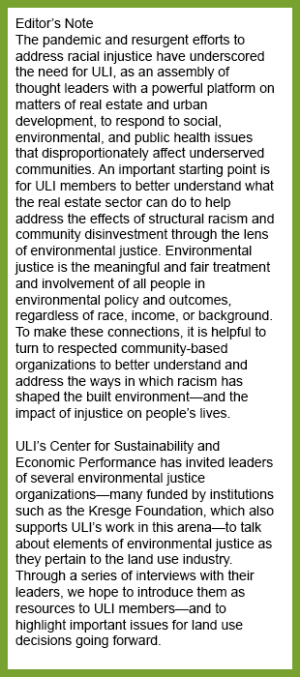Real estate practitioners can drive meaningful advances in equity by learning about, and partnering with, community-based organizations committed to change.
Policies of environmental injustice, which have disadvantaged low-income communities and communities of color for decades, have longstanding effects on individuals’ lives today.
A recent study published in the journal Climate found that temperatures in formerly redlined neighborhoods are about 13 degrees Fahrenheit (7.2 degrees C) hotter than those in nonredlined neighborhoods. This indicates that communities of color are more exposed to the urban heat island effect—a phenomenon in which built surfaces absorb and reemit the sun’s heat—and its pernicious impacts on health and quality of life.
Research has also consistently shown that communities of color are exposed to substantially more polluted air and are more likely to be located near noxious power plants and other toxic sites. Moreover, lower-income and non-White individuals are less likely to have access to open space in their neighborhoods, according to “Spatial Disparities in the Distribution of Parks and Green Spaces in the USA,” a paper published by the U.S. Department of Health and Human Services and the Centers for Disease Control and Prevention.
A ULI technical assistance panel (TAP) that I chaired in 2017, focused on the industrial Brooklyn neighborhood of Gowanus, developed recommendations for how major proposed changes in land use policies, real estate strategies, and urban design approaches could combat these environmental justice challenges.
The TAP’s proposals, codeveloped with ULI’s community-based partner the Fifth Avenue Committee, helped inform a neighborhood rezoning proposal that would address the urban heat island effect, improving the health and quality of life of residents while facilitating new development.
One TAP recommendation worth greater investigation nationally is to require that all environmental review procedures consider the potential community impacts from urban heat island conditions and offer mitigation as warranted. Why not apply such a policy nationally and attract necessary resources to burdened communities?
ULI initiatives challenge real estate and urban development practitioners to consider the role that they can play in fulfilling a community’s social, environmental, and economic needs, suggesting a way forward for the Institute as it seeks to be more cognizant of its ability to lead positive change. ULI has always been an astute convenor of professionals from all real estate disciplines; it is a smart decision for the Institute to engage in more robust dialogues and partnerships with community-based organizations that know their communities best and advocate for social and environmental justice within them. Collaborations of this sort are foundational to the creation of equitable economic opportunity, inclusive social and environmental infrastructure, and expanded affordable and accessible housing choices that meet local needs.
Four Organizations Advocating for Environmental Justice
- Catalyst Miami
- Fifth Avenue Committee (New York City)
- Initiative for Energy Justice (Boston)
- The Greenlining Institute (Oakland)
In my real estate and economic advisory firm’s work across the country, we consistently see the economic, social, and environmental good that springs from such collaboration. In San Jose, for example, we are advising the San Francisco Bay Area Planning and Urban Research Association (SPUR) on how some of the value created through park improvements and the real estate investments they generate can be captured and reinvested to fund place management and other public realm improvements that will benefit underserved residential communities. These projects can also be enormous value creators for downtown developers, owners, and anchor businesses. In Pensacola, Florida, we made the policy argument to the local government that public investments in a waterfront redevelopment plan would provide a reasonable return on that investment and, equally important, would form an essential component of a broader equitable economic development strategy in a city that, like so many others, is taking meaningful steps to right the wrongs of past systemic racism.
Let’s all see to it that ULI and its programs continue to be enriched by deep engagement with the network of capable, community-based organizations across the country that have long been advocating for local needs. The challenges ahead are as daunting as we have ever known. Surely the best way forward is through forging diverse partnerships and collaborations intent on addressing environmental justice and doing the ongoing work needed to transform cities and regions into more resilient—and more equitable—economies and communities.
JAMES LIMA is president of James Lima Planning + Development and a member of the ULI Sustainable Development Council.






